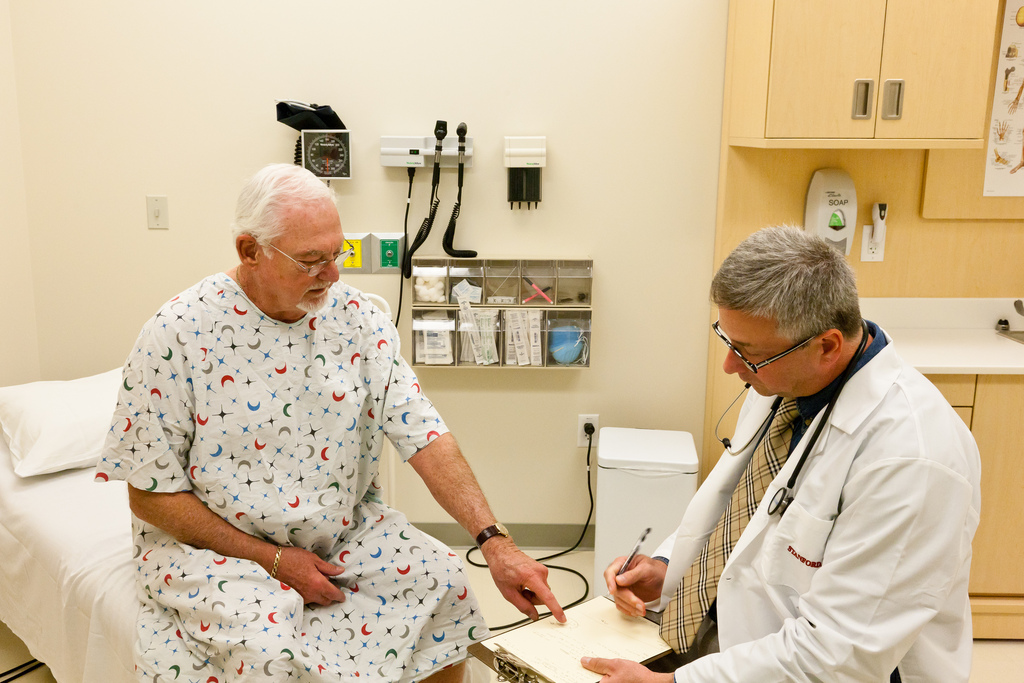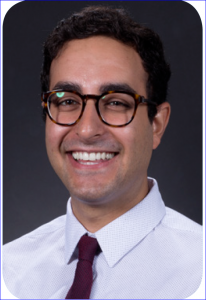Tony Catt’s job requires a metamorphosis. He’s a retired health/safety manager who looks like he could be a long-lost uncle of a character from a show he enjoys watching, Sons of Anarchy. Catt is a burly Englishman with tattoos, pierced ears, and a warm personality.
On the days he’s called into work, Catt departs from his East Valley home and heads toward the University of Arizona College of Medicine—Phoenix campus. He floats to the third floor and materializes as Lou Baker, a 61-year-old painter with a particularly bothersome right shoulder who doesn’t have insurance and is intensely worried that his pain could be something serious, which could prevent him from being able to continue to work.
Many medical schools across the country hire local community members, like Catt, to work as standardized patients, or SPs for short, in order to help train budding medical students practice a variety of skills in a simulated setting. Students learn to properly obtain a patient’s history, perform a thorough physical exam, and communicate their findings to physicians. Within the safety of role-playing, skills and techniques are refined, and mistakes are freely made without repercussions.
“This is what we’re here for,” Catt said. “It doesn’t matter if you make a mistake with me. I’ve been here 10 years, and no SP has ever died because of a student’s mistake—this is all about repetition and getting better every encounter.”
Standardized patients are essential in shaping the careers of the future physicians of this country. In fact, the National Board of Medical Examiners, the entity that is responsible for providing medical license examinations, depends on standardized patients to test every student’s doctoring abilities. Medical students unable to pass this examination, known as the Step 2CS, are not able to obtain their medical licenses. Not too long ago, this examination didn’t exist. In fact, academic physicians didn’t recruit the public to portray sick patients until the 1960s.
It was Dr. Howard Barrows, a neurology educator at the University of Southern California, who invented the idea of a standardized patient less than 60 years ago. Unable to find patients with the specific psychiatric and neurological findings that students could practice their skills on, Barrows was inspired to recruit an artists’ model from the USC Art Department named Rose McWilliams, the first standardized patient. She would role play as Patty Dugger, a paraplegic woman with multiple sclerosis who would demonstrate a simulated positive Babinski sign among other symptoms. At the time, medical institutions considered the practice detrimental to medical education and the Associated Press even wrote an article that ridiculed the process. Hollywood was invading medical education and “making life a little more interesting for USC medical students.” It wasn’t until years later in the 1970s when the need for a comprehensive methodology in evaluating students and the work of Dr. Paula Stillman, the pediatric clerkship director at the medical school at the University of Arizona in Tucson, that the medical community legitimize the good work of SPs. Stillman’s contribution came from employing SP mothers to give histories of common pediatric complaints to students. It led to her development of the famous, “Arizona Scale” to formally assess a student’s medical interviewing skills.
Today, standardized patients at the UA COM-P are paid 20 dollars for every hour of work. That includes the initial full-day of training for newly hired SPs, the three-hour training sessions for each case, and the time they spend role-playing with the students, among other duties. (SPs can also volunteer to allow for pelvic or rectal exams to be performed on them. Female SPs are paid an extra 100 dollars for every pelvic exam and male SPs get an extra 50 dollars for every rectal exam.) For many of the SPs, including Catt, compensation is an added benefit.
“I’d almost do this job for nothing, just because of the enjoyment and satisfaction I get out of it,” Catt said. “The biggest problem about this job is that there’s not enough of it. I’d love to be down here every day of the week.”
Nine years ago, Laura Weissman, an owner of a local dog shelter, joined the doctoring program as an SP because of her experience of growing up with a childhood illness. She knows first-hand that becoming a great doctor requires much more than a correct diagnosis. In some instances, feedback from an observant SP could provide students with an everlasting enlightened perspective.
“Making sure that the human element is really present in the medical world is the most important part of what I do,” Laura said. “I think sometimes, it is easy to forget that element, and I think being an SP really helps bring that home.”
Although the doctoring program at UA COM-P emphasizes the typical doctoring skills, Dr. Marícela Moffitt, the program’s creator and director, who also practices at the Carl T. Hayden VA in Phoenix as a Hospitalist, has also initiated a change to the culture of teaching exam-taking by asking medical students to include questions and strategies that would allow them to consider their patient’s feelings and dignity. SPs are also required to provide feedback after every student encounter so that students are aware of their behaviors and actions. Doing so allows students to develop the skills to speak and empathize with their patients, especially when there may be days when students are confronted with cases related to domestic violence or sex trafficking.
“These are emotionally draining days,” Dr. Moffitt said. “But experiences like that prepare [medical students] better for when [they] do see these patients, because [they] will.”
Molly Kurtz and Christiann Thijm, two adult educators who work closely with training SPs at UA COM-P, sincerely appreciate the work that SPs do. They, themselves, were SPs in the program before accepting their current positions. They believe there are some misconceptions people might have about the work that SPs do.
“I think most people don’t really understand how truly complex it is to be an SP. To have memorized a whole series of things, including verbatim responses,” Kurtz said. “To be able to know that is hard enough, but then they also have to be able to observe the behaviors of a student and remember them whilst reciting that information.”
For Thijm, having SPs working with students early on cultivates an environment for students to develop meaningful connections with their patients, in hopes that its importance does not diminish when students graduate.
“I really truly want to see great doctor-patient interactions for all people, my family, my friends, humanity,” Thijm said. “It’s not, ‘you got the wrong fries at Burger King.’ It’s something more important.”
After working nearly 10 years as an SP, Catt doesn’t tire of observing each student go through their own metamorphosis. It’s why he continues to come back every year as an SP and hopes to for many more years to come.
“Just to see the transformation between this nervous, stuttering, know-nothing to what they can do in three or four months is just amazing,” Catt said. “There is satisfaction in knowing that maybe I had just a tiny bit to do with that.”
In echoing and amplifying Catt’s contribution as an SP, Dr. Moffitt is comfortable in acknowledging that the success of the doctoring curriculum she created would not have been possible without her standardized patients.
“[Students] having the ability to actually practice this with SPs makes [them] so much more confident,” Moffitt said. “This is the gift of doctoring—confidence.”
Dara Farhadi is a member of The University of Arizona College of Medicine – Phoenix, Class of 2022. He graduated from The University of Arizona in 2016 with a degree in Neuroscience and Cognitive Science and then received a master's degree in Science Journalism from Boston University. He enjoys art and playing tennis. You can contact him via twitter @Dara_Farhadi


